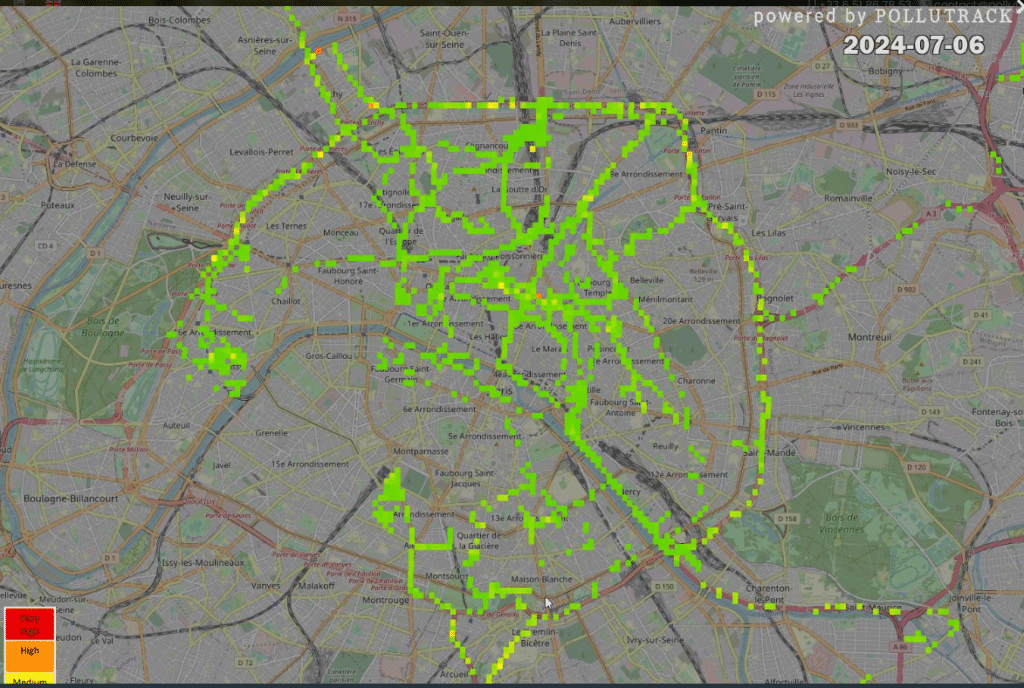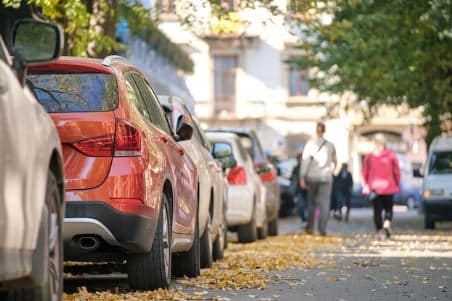
I. What are the Challenges of Pollution and CO2 Sensors?
Pollution sensors play a crucial role in monitoring air quality and the environment. They collect precise data on the levels of various pollutants, providing essential information for protecting public health and preserving the environment. To help you find your way around and make the right decisions, discover our smart city guide. Key issues include :
Public health protection from pollution
Air pollution is linked to numerous health problems, including respiratory and cardiovascular diseases and certain cancers. Sensors can detect dangerous levels of pollutants and alert the population. For example, micro-sensors can be used by people with respiratory illnesses or athletes to monitor their individual exposure to air pollution.
Preserving the environment
By monitoring pollutant emissions, sensors help identify pollution sources and implement measures to reduce their impact on ecosystems. Sensors integrated into irrigation systems, pipelines, reservoirs and weather stations enable continuous monitoring of the environment.
Policies and regulations
The data collected by pollution sensors is crucial to the development and application of effective environmental policies. They provide a sound scientific basis for justifying new regulations and verifying compliance with existing air quality standards.
Public awareness and education
The information provided by the sensors can raise public awareness of air quality and encourage more environmentally-friendly behavior. Publishing pollution data in real time promotes transparency and can encourage greener lifestyle choices, such as the adoption of sustainable modes of transport.
II. What are the different types of pollution to be detected?

Pollution sensors measure various types of pollutants present in the air. The main types of pollution monitored include :
Air Pollutants
Fine particles (PM2.5 and PM10)
Small airborne solid or liquid particles from vehicles, industry and other combustion sources.
Particles are classified according to their size:
- PM10: particles with a diameter of less than 10 micrometers. They are retained in the nose and upper airways;
- PM2.5: particles smaller than 2.5 micrometers in diameter. They penetrate deep into the respiratory tract to the pulmonary alveoli, and can pass into the bloodstream.
Particulates are particularly harmful to health. They cause irritation and respiratory problems in sensitive people, and are associated with increased mortality (respiratory ailments, cardiovascular disease, cancer, etc.). In fact, they’re the ones that blacken the facades of urban buildings.
Nitrogen oxides (NO2 and NOx)
Emitted mainly by vehicles and power plants, this gas irritates the bronchi and promotes asthma attacks and lung infections. Asthmatics and young children are more sensitive to this pollutant.
Sulfur dioxide (SO2)
Comes from the combustion of fossil fuels (fuel oil, coal, etc.). Some industrial processes also emit sulfur oxides, such as sulfuric acid production, pulp and paper production, petroleum refining and so on. They can also be emitted by nature, notably by volcanoes. They cause irritation of mucous membranes, skin and respiratory tract (coughing, respiratory discomfort, asthmatic disorders).
Carbon monoxide (CO)
Result of incomplete combustion of fuels, dangerous in high concentrations.
Tropospheric Ozone (O3)
Ozone (O3) is a gas essential to life on earth. Naturally present in the atmosphere, it forms a layer in the stratosphere that protects against ultraviolet rays. Over 97% of ultraviolet rays are intercepted by this layer. In the lower atmosphere, on the other hand, ozone is a harmful atmospheric pollutant for human health, animals and plants, due to its oxidizing properties.
Ozone thus has significant negative effects on health. It is irritating to the respiratory system and eyes, and is associated with increased mortality during pollution episodes.

Chemical Pollutants
Volatile organic compounds (VOCs)
The family of volatile organic compounds (VOCs) includes all molecules made up of hydrogen and carbon atoms (hydrocarbons), and those in which the hydrogen atoms are replaced by other atoms such as nitrogen, chlorine, sulfur or oxygen. These are gases and vapors that can evaporate more or less rapidly at room temperature.
Heavy metals
Heavy metals comprise a vast family of compounds (lead, mercury, arsenic, nickel, cadmium, zinc, chromium, etc.), most of which are found in particulate form, with the exception of mercury (in gaseous form). They come from the combustion of coal, oil, household waste and certain industrial processes (non-ferrous metal metallurgy in particular). Certain metals such as cadmium, mercury, lead and chromium are found in tobacco smoke.
Biological Pollutants
Biological pollutants are any contaminants present in our environment that originate from living organisms. Some common examples include plant and tree pollen, animal excrement (urine, feces, dander, skin cells, saliva, etc.), dust mites, fungi such as mold and mildew, insects and pathogens such as bacteria and viruses.
III. Pollution and CO2 Sensor Implementation Success Stories

There are many projects to implement pollution and CO2 sensors. An ATMO observatory and federation, and a CINOV federation, exist and list these air quality monitoring projects.
Anthony – BP2018, project 6: air quality, sensors and data dissemination: detection of fine particles (PM10, PM2.5 and PM1) and nitrogen dioxide (NO2)
The town of Antony has deployed a network of pollution sensors as part of its smart city initiative. These sensors measure several atmospheric pollutants in real time, including fine particles (PM10, PM2.5 and PM1) and nitrogen dioxide (NO2). The idea of this project is to involve Antonians in the measurement of air quality in their neighborhood, and to give them access to the measurements taken.
Sensors deployed at numerous sites provide measurements and respond to citizens’ need to know the state of air quality at a specific location and at a given moment. This project aims to raise public awareness of air pollution issues and help local decision-makers take informed action to improve air quality.
The European CITI-SENSE project: detection of relative humidity, temperature, noise, CO2, NO2, fine particles (PM10, PM2.5), ozone, CO (cobalt) and radon.
CITI-SENSE was a project funded by the European Union as part of the 7th Framework Program (FP7), with a budget of around 12 million euros. The aim was to develop and deploy air pollution sensors in 9 European cities, including Oslo, Barcelona, Ljubljana, Belgrade, Vienna, Edinburgh, Haifa, Ostrava and Vitoria-Gasteiz. The project focused on civic engagement, encouraging residents to take part in air quality data collection. CITI-SENSE has also developed data visualization and interpretation tools to make information accessible to the general public. The project has helped to improve our understanding of the spatial and temporal variability of air pollution in urban environments.
Mexico – VER-PM 2.5 project: air quality measurement through sensors
This is a research initiative on particulate air pollution that uses low-cost sensors in combination with regulatory-grade equipment. With these sensors, a network is built for continuous monitoring of the concentration of particles smaller than 2.5 µm (PM2.5), which will have sufficiently wide coverage to describe their spatial distribution in the central region of Mexico.
London – Breath London: detection of fine particles and NO2
London Breath is an innovative project to map air pollution in London. It uses wearable sensors that volunteer citizens wear on their daily journeys. These sensors continuously measure pollution levels, including NO2 and fine particles. The data collected is geolocated and aggregated to create a detailed, dynamic map of air pollution in the city.
This project aims to provide a finer understanding of individual exposure to pollution, taking into account local and temporal variations that fixed measuring stations cannot capture. London Breath also helps to raise awareness of urban air quality issues among participants and the public, and to encourage changes in behavior to reduce exposure to pollution.
Paris – Pollutrack: PM2.5 detection
The Pollutrack project in Paris is an innovative initiative to monitor air quality in real time using a fleet of vehicles equipped with pollution sensors. Launched by Paris City Hall in collaboration with Airparif and other organizations, Pollutrack uses around 400 vehicles, including 300 fromEnedis and 100 VTCs from operator Marcel, to collect data on PM2.5 fine particles. These vehicles criss-cross the city, transmitting around two million readings every day to create a precise, interactive map of air pollution in Paris.
The Pollutrack card in Paris
The map, which can be accessed online, is updated every hour and enables Parisians to find out about pollution levels in their neighborhoods, as well as the forecast for the following day. This system not only helps to raise public awareness, but also to identify pollution hotspots and take measures to improve air quality in the capital.

V. Budget examples for Pollution Sensor Projects
| City | Size | Total budget | Number of sensors | Types of pollutants measured | Remarks |
|---|---|---|---|---|---|
| Anthony | Population: 61,700 | 12.000€ | 10+ sensors | Fine particulate matter (PM 1 – 2.5 – 10), NO2 | |
| CITI-SENSE project 9 cities across the EU | ~7.1 M cumulative inhabitants | 12.3 million | 324 sensors and 24 observatories | relative humidity, temperature, noise, CO2, NO2, fine particulates (PM10, PM2.5), ozone, CO (cobalt) and radon (radioactive gas) | 8.9 million euros were financed by the EU) |
| Breath London (London) | 8.7 M inhabitants | 750.000€ | 420 sensors | Fine particulates (PM2.5) and nitrogen oxide | This is the initial budget |
| Strasbourg | 277,000 inhabitants | 10.000€ | 60 sensors | Fine particles: PM10 and PM2.5 or even ultra-fine particles gas measurement: nitrogen oxides NO2 and even ozone O3 | This is a participatory project submitted in December 2018. |
VI- Examples of pollution sensor suppliers
| Supplier name | Pollution sensor types | Types of solutions | country | Official link |
| Clarity | Clarity Node-S (PM, NO2) Wind module (wind speed and direction) Ozone module (highly accurate nitrogen measurements) Black carbon module (details the composition of light-absorbing carbon particles to detect various sources such as diesel or tobacco) | Sensing-as-a-service / Air quality monitoring | USA | official link |
| Nanosense | – EP5000 IAQ sensor 13 measurements and intelligent control of ventilation, heating and air conditioning – QAA probe Measures outdoor air quality with 6 measurements. | Pollution sensors Ventilation management for underground parking lots | France | official link |
| Luftmy | Air quality sensor module(LD15TV) temperature, humidity, VOCs and PM2.5 | Optical particle sensors Intelligent gas sensors High-end gas analysis instruments | China | official link |
| Honeywell | HPM Series PM1.0, PM2.5, PM4 ET PM10 | Industrial automation, detection, defense, aerospace, home automation | USA | official link |
| Kunak |
Kunak AIR Pro
particulate matter (TCP, TSP, PM10, PM2.5, PM4, PM1), CO, CO2, NO, NO2, O3, H2S, SO2, NH3, VOC, CH4 and HCl. Weather parameters such as temperature, relative humidity, pressure, noise and other accessories are also available. | sensors and solutions for precise gas and particle analysis. | Spain | official link |
In brief: pollution and CO2 sensor
Pollution sensors are essential tools for understanding and improving air quality in cities. Successful implementation often depends on maintenance, inter-agency coordination and financial and political support.
As is often the case with smart cities, approaches vary widely, as do solution budgets. This is also the case for intelligent parking sensors. Well-executed projects can lead to healthier environments and a better quality of life for citizens.



